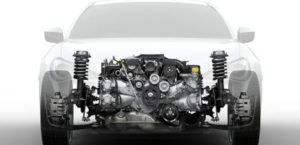BMW 7-Series
The BMW 7 Series is a series of German luxury sedan cars produced by BMW AG since 1977. Since 2015, the 6th generation of models has been released. The latest generation machines are based on the OKL platform. The chassis of this modular platform is created using the carbon fiber reinforcement technology used in modern BMW i electric vehicles. About 50 thousand 7-series cars are produced annually, most of which are sold in the USA and China.
BMW 7 series, 1st generation (E23), 1977–1987

The first BMW 7-series in the body of the E23 appeared before the public in 1977. Its progenitor was the large BMW New Six sedan, from which, by the way, the 7-series initially completely borrowed the engine range. Under the hood of a luxury car, there were six-cylinder engines with a volume of 2.5-3.5 liters.
In 1980, a version appeared with the only turbo engine in the line – 745i. The volume of this engine was 3.2 liters, and the maximum power was 252 hp. But this is not the limit – for the South African market there was a special version of the 745i with a 286-horsepower naturally aspirated engine, however, only a little more than two hundred such cars were produced. In addition to the engine, the buyer had to choose a transmission – a three- or four-speed automatic or a four- or five-speed manual.
BMW 7 series, 2nd generation (E32), 1986–1994

By 1986, the E23 was noticeably outdated and could not keep up with its competitor in the face of Mercedes. It was this year that it was replaced by the new 7-series with the factory designation E32. The first years of production, the novelty used all the same three-liter engines from its predecessor, and they were equipped with a manual gearbox with five gears or a four-speed automatic transmission.
1987 was the date when an executive car for the first time combined comfort and enviable speed characteristics. We are talking about the appearance of a version of the 750i, in which a 300-horsepower V12 raged under the hood, and which accelerated to 100 km/h in just 6.6 seconds. This sedan was the first BMW to feature an electronic speed limiter at around 250 km/h.
In 1992, the model was restyled, giving the “thirty-second” two new V8 engines with volumes of 3 and 4 liters for the 730i and 740i versions, respectively.
BMW 7 series, 3rd generation (E38), 1994–2001

It was impossible to delay updating the 7-series, and in 1994 the Bavarians showed the third generation of the 7-series in the back of the E38.
The car looked much fresher and even more dynamic, and, by the way, it not only looked more dynamic, but also was. Comfort was also taken care of in the 7 series – many innovative electronic systems were introduced that made the work of power units, transmission and suspension more measured. Buyers were offered gasoline versions of the 728i, 730i, 735i, 740i and 750i with engines from 2.8 to 5.4 liters and power from 193 to 326 hp, as well as for the first time in the history of the 7-series diesel 725tds, 730d and 740d, whose engines produced 143, 193 and 245 hp, respectively.
BMW 7 series, 4th generation (E65), 2001–2008

At the turn of the millennium, all automobile companies sought to show something fundamentally new, tearing patterns. The development of the fourth generation BMW 7-series just refers to this period. As a result, the 7-series in the back of the E65 turned out to be very unusual, significantly different from its predecessor and had several unusual elements, such as, for example, a rear bumper that hid the exhaust system pipes from the eyes. Not everyone considered this design successful, but sales did not worsen from this. The simplest engine for the novelty was a 228-horsepower gasoline unit for the 730i version, and the pinnacle of progress was the six-liter V12 from the 760i. The power of this engine reached 445 hp, which allowed the impressive flagship to gain 100 km / h in 5.5 seconds.
In 2005, there was a restyling that brought changes not only to the interior and exterior, but also to the engine range. The same six-liter giant remained the top one, but almost all of its younger brothers were replaced with more technologically advanced engines.
BMW 7 series, 5th generation (F01/F02), 2008–2015

The BMW 7-series executive sedan has been produced since 2008 in Germany, in 2012 the car was modernized.
The car was equipped with petrol and diesel engines 3.0, 4.4, 6.0. Drive – rear or full. The car is offered in both regular and extended versions. The gearbox is only an eight-speed automatic.
BMW 7 series, 6th generation (G11/G12), 2015

The BMW 7 Series is a large executive sedan, the sixth generation of which has been produced since 2015 at the plant in Dingolfing, Germany.
The cars are equipped with petrol and diesel turbo engines, all versions have an eight-speed automatic transmission. The drive can be rear or full. In 2019, the model was restyled.






